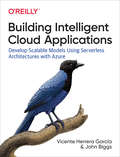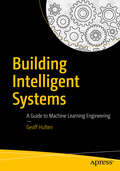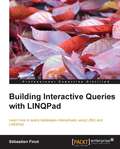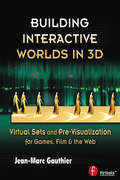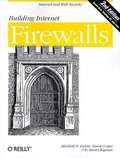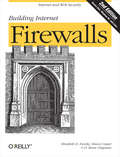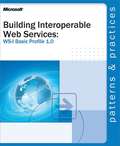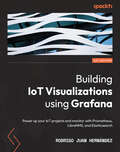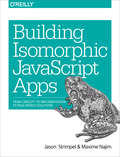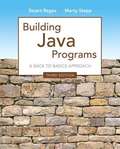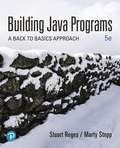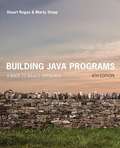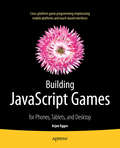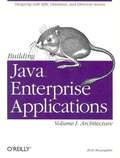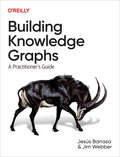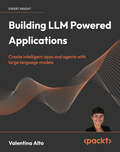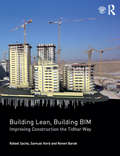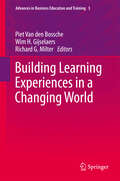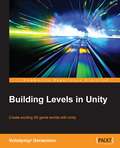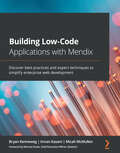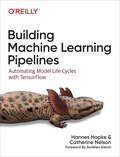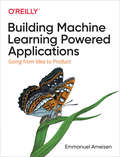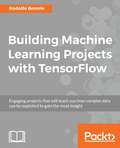- Table View
- List View
Building Intelligent Cloud Applications: Develop Scalable Models Using Serverless Architectures with Azure
by John Biggs Vicente Herrera GarcíaServerless computing is radically changing the way we build and deploy applications. With cloud providers running servers and managing machine resources, companies now can focus solely on the application’s business logic and functionality. This hands-on book shows experienced programmers how to build and deploy scalable machine learning and deep learning models using serverless architectures with Microsoft Azure.You’ll learn step-by-step how to code machine learning into your projects using Python and pretrained models that include tools such as image recognition, speech recognition, and classification. You’ll also examine issues around deployment and continuous delivery, including scaling, security, and monitoring.This book is divided into three parts with application examples woven throughout:Cloud-based development: Learn the basics of serverless computing with machine learning, Functions-as-a-Service (FaaS), and the use of APIsAdding intelligence: Create serverless applications using Azure Functions; learn how to use prebuilt machine learning and deep learning modelsDeployment and continuous delivery: Get up to speed with Azure Kubernetes Service, Azure Security Center, and Azure Monitoring
Building Intelligent Systems: A Guide To Machine Learning In Practice
by Geoff HultenProduce a fully functioning Intelligent System that leverages machine learning and data from user interactions to improve over time and achieve success.This book teaches you how to build an Intelligent System from end to end and leverage machine learning in practice. You will understand how to apply your existing skills in software engineering, data science, machine learning, management, and program management to produce working systems.Building Intelligent Systems is based on more than a decade of experience building Internet-scale Intelligent Systems that have hundreds of millions of user interactions per day in some of the largest and most important software systems in the world. What You’ll Learn Understand the concept of an Intelligent System: What it is good for, when you need one, and how to set it up for successDesign an intelligent user experience: Produce data to help make the Intelligent System better over timeImplement an Intelligent System: Execute, manage, and measure Intelligent Systems in practiceCreate intelligence: Use different approaches, including machine learningOrchestrate an Intelligent System: Bring the parts together throughout its life cycle and achieve the impact you want Who This Book Is For Software engineers, machine learning practitioners, and technical managers who want to build effective intelligent systems
Building Interactive Queries with LINQPad
by Sebastien FinotA step-by-step practical guide that will introduce you to LINQPad's key features, thereby helping you to query databases interactively.This book is aimed at C#/.Net developers who wish to learn LINQ programming and leverage the easy way of using LINQPad. No prior knowledge of LINQ or LINQPad is expected. A basic knowledge of SQL and XML is required for some chapters.
Building Interactive Worlds in 3D: Virtual Sets and Pre-visualization for Games, Film & the Web
by Jean-Marc GauthierIn Building Interactive Worlds in 3D readers will find turnkey tutorials that detail all the steps required to build simulations and interactions, utilize virtual cameras, virtual actors (with self-determined behaviors), and real-time physics including gravity, collision, and topography. With the free software demos included, 3D artists and developers can learn to build a fully functioning prototype. The book is dynamic enough to give both those with a programming background as well as those who are just getting their feet wet challenging and engaging tutorials in virtual set design, using Virtools. Other software discussed is: Lightwave, and Maya. The book is constructed so that, depending on your project and design needs, you can read the text or interviews independently and/or use the book as reference for individual tutorials on a project-by-project basis. Each tutorial is followed by a short interview with a 3D graphics professional in order to provide insight and additional advice on particular interactive 3D techniques-from user, designer, artist, and producer perspectives.
Building Internet Firewalls, 2nd Edition
by D. Brent Chapman Simon Cooper Elizabeth D. ZwickyCompletely revised and much expanded, the new edition of the highly respected and bestselling Building Internet Firewalls now covers Unix, Linux, and Windows NT. This practical and detailed guide explains in step-by-step fashion how to design and install firewalls and configure Internet services to work with a firewall. It covers a wide range of services and protocols and offers a complete list of resources, including the location of many publicly available firewalls construction tools.
Building Internet Firewalls, 2nd Edition
by D. Brent Chapman Simon Cooper Elizabeth D. ZwickyCompletely revised and much expanded, the new edition of the highly respected and bestselling Building Internet Firewalls now covers Unix, Linux, and Windows NT. This practical and detailed guide explains in step-by-step fashion how to design and install firewalls and configure Internet services to work with a firewall. It covers a wide range of services and protocols and offers a complete list of resources, including the location of many publicly available firewalls construction tools.
Building Internet Firewalls: Internet and Web Security
by D. Brent Chapman Simon Cooper Elizabeth D. ZwickyIn the five years since the first edition of this classic book was published, Internet use has exploded. The commercial world has rushed headlong into doing business on the Web, often without integrating sound security technologies and policies into their products and methods. The security risks--and the need to protect both business and personal data--have never been greater. We've updated Building Internet Firewalls to address these newer risks.What kinds of security threats does the Internet pose? Some, like password attacks and the exploiting of known security holes, have been around since the early days of networking. And others, like the distributed denial of service attacks that crippled Yahoo, E-Bay, and other major e-commerce sites in early 2000, are in current headlines.Firewalls, critical components of today's computer networks, effectively protect a system from most Internet security threats. They keep damage on one part of the network--such as eavesdropping, a worm program, or file damage--from spreading to the rest of the network. Without firewalls, network security problems can rage out of control, dragging more and more systems down.Like the bestselling and highly respected first edition, Building Internet Firewalls, 2nd Edition, is a practical and detailed step-by-step guide to designing and installing firewalls and configuring Internet services to work with a firewall. Much expanded to include Linux and Windows coverage, the second edition describes:Firewall technologies: packet filtering, proxying, network address translation, virtual private networksArchitectures such as screening routers, dual-homed hosts, screened hosts, screened subnets, perimeter networks, internal firewallsIssues involved in a variety of new Internet services and protocols through a firewallEmail and News Web services and scripting languages (e.g., HTTP, Java, JavaScript, ActiveX, RealAudio, RealVideo)File transfer and sharing services such as NFS, SambaRemote access services such as Telnet, the BSD "r" commands, SSH, BackOrifice 2000 Real-time conferencing services such as ICQ and talk Naming and directory services (e.g., DNS, NetBT, the Windows Browser) Authentication and auditing services (e.g., PAM, Kerberos, RADIUS); Administrative services (e.g., syslog, SNMP, SMS, RIP and other routing protocols, and ping and other network diagnostics) Intermediary protocols (e.g., RPC, SMB, CORBA, IIOP)Database protocols (e.g., ODBC, JDBC, and protocols for Oracle, Sybase, and Microsoft SQL Server)The book's complete list of resources includes the location of many publicly available firewall construction tools.
Building Interoperable Web Services: WS-I Basic Profile 1.0
by Microsoft Corporation<div xmlns="http://www.w3.org/1999/xhtml"><p>This guide helps you design and code interoperable Web services by explaining and illustrating how to properly apply the guidelines created by the Web Services Interoperability (WS-I) organization in its Basic Profile version 1.0.</p></div>
Building IoT Visualizations using Grafana: Power up your IoT projects and monitor with Prometheus, LibreNMS, and Elasticsearch
by Rodrigo Juan HernandezThe IoT developer's complete guide to building powerful dashboards, analyzing data, and integrating with other platformsKey FeaturesConnect devices, store and manage data, and build powerful data visualizationsIntegrate Grafana with other systems, such as Prometheus, OpenSearch, and LibreNMSLearn about message brokers and data forwarders to send data from sensors and systems to different platformsBook DescriptionGrafana is a powerful open source software that helps you to visualize and analyze data gathered from various sources. It allows you to share valuable information through unclouded dashboards, run analytics, and send notifications. Building IoT Visualizations Using Grafana offers how-to procedures, useful resources, and advice that will help you to implement IoT solutions with confidence. You'll begin by installing and configuring Grafana according to your needs. Next, you'll acquire the skills needed to implement your own IoT system using communication brokers, databases, and metric management systems, as well as integrate everything with Grafana. You'll learn to collect data from IoT devices and store it in databases, as well as discover how to connect databases to Grafana, make queries, and build insightful dashboards. Finally, the book will help you implement analytics for visualizing data, performing automation, and delivering notifications. By the end of this Grafana book, you'll be able to build insightful dashboards, perform analytics, and deliver notifications that apply to IoT and IT systems.What you will learnInstall and configure Grafana in different types of environmentsEnable communication between your IoT devices using different protocolsBuild data sources by ingesting data from IoT devicesGather data from Grafana using different types of data sourcesBuild actionable insights using plugins and analyticsDeliver notifications across several communication channelsIntegrate Grafana with other platformsWho this book is forThis book is for IoT developers who want to build powerful visualizations and analytics for their projects and products. Technicians from the embedded world looking to learn how to build systems and platforms using open source software will also benefit from this book. If you have an interest in technology, IoT, open source, and related subjects then this book is for you. Basic knowledge of administration tasks on Linux-based systems, IP networks and network services, protocols, ports, and related topics will help you make the most out of this book.
Building IoT Visualizations using Grafana: Power up your IoT projects and monitor with Prometheus, LibreNMS, and Elasticsearch
by Rodrigo Juan HernándezThe IoT developer\'s complete guide to building powerful dashboards, analyzing data, and integrating with other platformsKey FeaturesConnect devices, store and manage data, and build powerful data visualizationsIntegrate Grafana with other systems, such as Prometheus, OpenSearch, and LibreNMSLearn about message brokers and data forwarders to send data from sensors and systems to different platformsBook DescriptionGrafana is a powerful open source software that helps you to visualize and analyze data gathered from various sources. It allows you to share valuable information through unclouded dashboards, run analytics, and send notifications. Building IoT Visualizations Using Grafana offers how-to procedures, useful resources, and advice that will help you to implement IoT solutions with confidence. You’ll begin by installing and configuring Grafana according to your needs. Next, you’ll acquire the skills needed to implement your own IoT system using communication brokers, databases, and metric management systems, as well as integrate everything with Grafana. You’ll learn to collect data from IoT devices and store it in databases, as well as discover how to connect databases to Grafana, make queries, and build insightful dashboards. Finally, the book will help you implement analytics for visualizing data, performing automation, and delivering notifications. By the end of this Grafana book, you’ll be able to build insightful dashboards, perform analytics, and deliver notifications that apply to IoT and IT systems.What you will learnInstall and configure Grafana in different types of environmentsEnable communication between your IoT devices using different protocolsBuild data sources by ingesting data from IoT devicesGather data from Grafana using different types of data sourcesBuild actionable insights using plugins and analyticsDeliver notifications across several communication channelsIntegrate Grafana with other platformsWho this book is forThis book is for IoT developers who want to build powerful visualizations and analytics for their projects and products. Technicians from the embedded world looking to learn how to build systems and platforms using open source software will also benefit from this book. If you have an interest in technology, IoT, open source, and related subjects then this book is for you. Basic knowledge of administration tasks on Linux-based systems, IP networks and network services, protocols, ports, and related topics will help you make the most out of this book.
Building Isomorphic JavaScript Apps: From Concept to Implementation to Real-World Solutions
by Jason Strimpel Maxime NajimIsomorphic JavaScript, often described as the holy grail of web application development, refers to running JavaScript code on both the browser client and web application server. This application architecture has become increasingly popular for the benefits of SEO, optimized page load and full control of the UI, and isomorphic libraries are being used at companies like Walmart, Airbnb, Facebook, and Netflix.With this practical book, authors Jason Strimpel and Maxime Najim provide the knowledge you need to build and maintain your own isomorphic JavaScript apps.This book includes:Part 1 identifies different classifications of isomorphic JavaScript apps, and shows you how to set up a development environmentPart 2 takes you from theory to practice by showing you how to build out your own isomorphic appPart 3 takes you through existing solutions in the market today, providing you with the knowledge you need to bring isomorphic solutions into your development workflow
Building Java Programs: A Back To Basics Approach
by Stuart Reges Marty SteppBuilding Java Programs: A Back to Basics Approach, Third Edition, introduces novice programmers to basic constructs and common pitfalls by emphasizing the essentials of procedural programming, problem solving, and algorithmic reasoning. By using objects early to solve interesting problems and defining objects later in the course, Building Java Programs develops programming knowledge for a broad audience. NEW! This edition is available with MyProgrammingLab, an innovative online homework and assessment tool. Through the power of practice and immediate personalized feedback, MyProgrammingLab helps students fully grasp the logic, semantics, and syntax of programming. Note: If you are purchasing the standalone text or electronic version, MyProgrammingLab does not come automatically packaged with the text. To purchase MyProgrammingLab, please visit: myprogramminglab. com or you can purchase a package of the physical text + MyProgrammingLab by searching the Pearson Higher Education web site. MyProgrammingLab is not a self-paced technology and should only be purchased when required by an instructor.
Building Java Programs: A Back To Basics Approach
by Stuart Reges Marty SteppEffective step-by-step Java education Building Java Programs: A Back to Basics Approach introduces new concepts and syntax using a spiral approach, ensuring students are thoroughly prepared as they work through CS1 material. Through the first four editions, Building Java Programs and its back-to-basics approach have proven remarkably effective. The 5th Edition has been extensively updated with incorporation of JShell integration, improved loop coverage, rewritten and revised case studies, examples, updated collection syntax and idioms, expanded self-check and programming exercising sections, and new programming projects.
Building Java Programs: A Back to Basics Approach
by Stuart Reges Marty SteppThe authors' proven and class-tested "back to basics" approach introduces programming fundamentals first, with new syntax and concepts added over multiple chapters, and object-oriented programming discussed only once readers have developed a basic understanding of Java programming.
Building JavaScript Games: for Phones, Tablets, and Desktop
by Arjan EggesBuilding JavaScript Games teaches game programming through a series of engaging, arcade-style games that quickly expand your JavaScript and HTML5 skills. JavaScript is in the top ten most-used programming languages world wide, and is the basis for applications that can run in any modern browser, on any device from smart phone to tablet to PC. Especial emphasis is given to touch-based interface, but all games also run using a regular mouse and keyboard setup. The four games you'll develop from reading this book are: Painter Jewel Jam Penguin Pairs Tick Tick These four games are casual, arcade-style games representing the aim-and-shoot, puzzle, maze, and platform styles of game play. The approach in Building JavaScript Games follows the basic structure of a game rather than the syntax of a language. From almost the very first chapter you are building games to run on your phone or other device and show to your friends. Successive projects teach about handling player input, manipulating game objects, designing game worlds, managing levels, and realism through physics. All told, you'll develop four well-designed games, making Building JavaScript Games one of the most enjoyable ways there is to learn about programming browser-based games. The final chapters in the book contain a very nice bonus of sorts. In them you will find excerpts from interviews with two prominent people from the game industry: Mark Overmars, who is CTO of Tingly Games and creator of GameMaker, and Peter Vesterbacka, the CMO of Rovio Entertainment - the creators of the Angry Birds franchise. Their insight and perspective round off what is already a fun and valuable book.
Building JavaTM Enterprise Applications Volume I: Architecture
by Brett MclaughlinVolume 1 of this advanced 3-volume guide explores the infrastructure issues so important to good application design. It isn?t just a book about Entity Beans and JNDI. It takes you step by step through building the back end, designing the data store so that it gives you convenient access to the data your application needs; designing a directory; figuring out how to handle security and where to store security credentials you need; and so on.
Building Knowledge Graphs: A Practitioner's Guide
by Jim Webber Jesus BarrasaIncredibly useful, knowledge graphs help organizations keep track of medical research, cybersecurity threat intelligence, GDPR compliance, web user engagement, and much more. They do so by storing interlinked descriptions of entities—objects, events, situations, or abstract concepts—and encoding the underlying information. How do you create a knowledge graph? And how do you move it from theory into production?Using hands-on examples, this practical book shows data scientists and data engineers how to build their own knowledge graphs. Authors Jesús Barrasa and Jim Webber from Neo4j illustrate common patterns for building knowledge graphs that solve many of today’s pressing knowledge management problems. You’ll quickly discover how these graphs become increasingly useful as you add data and augment them with algorithms and machine learning.Learn the organizing principles necessary to build a knowledge graphExplore how graph databases serve as a foundation for knowledge graphsUnderstand how to import structured and unstructured data into your graphFollow examples to build integration-and-search knowledge graphsLearn what pattern detection knowledge graphs help you accomplishExplore dependency knowledge graphs through examplesUse examples of natural language knowledge graphs and chatbotsUse graph algorithms and ML to gain insight into connected data
Building LLM Powered Applications: Create intelligent apps and agents with large language models
by Valentina AltoGet hands-on with GPT 3.5, GPT 4, LangChain, Llama 2, Falcon LLM and more, to build LLM-powered sophisticated AI applicationsKey FeaturesEmbed LLMs into real-world applicationsUse LangChain to orchestrate LLMs and their components within applicationsGrasp basic and advanced techniques of prompt engineeringBook DescriptionBuilding LLM Powered Applications delves into the fundamental concepts, cutting-edge technologies, and practical applications that LLMs offer, ultimately paving the way for the emergence of large foundation models (LFMs) that extend the boundaries of AI capabilities. The book begins with an in-depth introduction to LLMs. We then explore various mainstream architectural frameworks, including both proprietary models (GPT 3.5/4) and open-source models (Falcon LLM), and analyze their unique strengths and differences. Moving ahead, with a focus on the Python-based, lightweight framework called LangChain, we guide you through the process of creating intelligent agents capable of retrieving information from unstructured data and engaging with structured data using LLMs and powerful toolkits. Furthermore, the book ventures into the realm of LFMs, which transcend language modeling to encompass various AI tasks and modalities, such as vision and audio. Whether you are a seasoned AI expert or a newcomer to the field, this book is your roadmap to unlock the full potential of LLMs and forge a new era of intelligent machines.What you will learnExplore the core components of LLM architecture, including encoder-decoder blocks and embeddingsUnderstand the unique features of LLMs like GPT-3.5/4, Llama 2, and Falcon LLMUse AI orchestrators like LangChain, with Streamlit for the frontendGet familiar with LLM components such as memory, prompts, and toolsLearn how to use non-parametric knowledge and vector databasesUnderstand the implications of LFMs for AI research and industry applicationsCustomize your LLMs with fine tuningLearn about the ethical implications of LLM-powered applicationsWho this book is for Software engineers and data scientists who want hands-on guidance for applying LLMs to build applications. The book will also appeal to technical leaders, students, and researchers interested in applied LLM topics. We don’t assume previous experience with LLM specifically. But readers should have core ML/software engineering fundamentals to understand and apply the content.
Building Lean, Building BIM: Improving Construction the Tidhar Way
by Rafael Sacks Samuel Korb Ronen BarakBuilding Lean, Building BIM is the essential guide for any construction company that wants to implement Lean Construction and Building Information Modelling (BIM) to gain a strategic edge over their competition. The first of its kind, the book outlines the principles of Lean, the functionality of BIM, and the interactions between the two, illustrating them through the story of how Tidhar Construction has implemented Lean Construction and BIM in a concerted effort over four years. Tidhar is a small-to-medium-sized construction company that pioneered a way of working that gave it a profit margin unheard of in its market. The company's story serves as a case study for explanation of the various facets of Lean Construction and BIM. Each chapter defines a principle of Lean and/or BIM, describes the achievements and failures in Tidhar's implementation based on the experiences of the key people involved, and reviews the relevant background and theory. The implementation at Tidhar has not been a pure success, but by examining their motives alongside their achievements and failures, readers will learn about what pitfalls and pinnacles to expect. A number of chapters also compare the experience of Tidhar with those of other companies who are leaders in their fields, such as Skanska and DPR. This book is highly relevant and useful to a wide range of readers from the construction industry, especially those who are frustrated with the inefficiencies in their companies and construction projects. It is also essential reading for Lean and BIM enthusiasts, researchers and students from a variety of industries and backgrounds.
Building Learning Experiences in a Changing World (Advances in Business Education and Training #3)
by Wim H. Gijselaers Piet Van den Bossche Richard G. MilterAdvances in Business Education & Training is a Book Series to foster advancement in the field of Business Education and Training. It serves as an international forum for scholarly and state-of-the-art research and development into all aspects of Business Education and Training. This new volume deals with several aspects of the challenge to design learning in and for a changing world. The first part concerns program development. How to build curricula that are future-proof? Principles to innovate our curricula are identified. It answers the question how we can incorporate the need for change in our thinking about curriculum-development and identify the necessary elements to incorporate in our curricula. The second part focuses on the increasing diversity of students and employees within our schools and organizations, in terms of culture, language, and perception of ability, gifts, and talents. This offers a range of opportunities, but at the same time can possibly jeopardize some processes that are taken for granted. Chapters in this part analyze the processes that play a crucial role in dealing with this diversity and identify educational practices that can help to harvest the potential that lies within this diversity. The third part of this book digs further into the possibilities that are opened up by the implementation of ICT-support in our learning environments. E-learning provides tools to adapt these environments to the needs of an increasingly diverse student-population. In the last part we focus specifically on the workplace and how learning can be designed in such a way that employees are equipped for a shifting workplace. On the one hand it is looked how training can affect performance in the workplace. Does learning transfer to the work environment? On the other hand it is questioned how one can design affordances to trigger learning in the workplace.
Building Levels in Unity
by Volodymyr GerasimovThe book is aimed at game artists with no past programming experience who are interested in designing levels in Unity. It does not assume detailed knowledge of similar game platforms.
Building Low-Code Applications with Mendix: Discover best practices and expert techniques to simplify enterprise web development
by Bryan Kenneweg Imran Kasam Micah McMullen Michael GuidoTransform your app ideas into fully functional prototypes with the help of expert tips and best practices from Mendix partnersKey FeaturesMeet the ever-increasing demand for software solution delivery without having to write any codeBuild high-availability, low-cost applications unlike those developed via a traditional software engineering approachExplore Mendix from product design through to delivery using real-world scenariosBook DescriptionLow-code is a visual approach to application development. It enables developers of varying experience levels to create web and mobile apps using drag-and-drop components and model-driven logic through a graphic user interface. Mendix is among the fastest-growing platforms that enable low-code enthusiasts to put their software ideas into practice without having to write much code, and Building Low-Code Applications with Mendix will help you get up and running with the process using examples and practice projects. The book starts with an introduction to Mendix, along with the reasons for using this platform and its tools for creating your first app. As you progress, you'll explore Mendix Studio Pro, the visual environment that will help you learn Mendix app creation. Once you have your working app ready, you'll understand how to enhance it with custom business logic and rules. Next, you'll find out how to defend your app against bad data, troubleshoot and debug it, and finally, connect it with real-world business platforms. You'll build practical skills as the book is filled with examples, real-world scenarios, and explanations of the tools needed to help you build low-code apps successfully. By the end of this book, you'll have understood the concept of low-code development, learned how to use Mendix effectively, and developed a working app.What you will learnGain a clear understanding of what low-code development is and the factors driving its adoptionBecome familiar with the various features of Mendix for rapid application developmentDiscover concrete use cases of Studio ProBuild a fully functioning web application that meets your business requirementsGet to grips with Mendix fundamentals to prepare for the Mendix certification examUnderstand the key concepts of app development such as data management, APIs, troubleshooting, and debuggingWho this book is forThis book is for tech-savvy business analysts and citizen developers who want to get started with Mendix for rapid mobile and web application development. The book is also helpful for seasoned developers looking to learn a new tool/platform and for anyone passionate about designing technical solutions without wanting to indulge in the complexities of writing code. The book assumes beginner-level knowledge of object-oriented programming and the ability to translate technical solutions from business requirements.
Building Machine Learning Pipelines: Automating Model Life Cycles With Tensorflow
by Hannes Hapke Catherine NelsonCompanies are spending billions on machine learning projects, but it’s money wasted if the models can’t be deployed effectively. In this practical guide, Hannes Hapke and Catherine Nelson walk you through the steps of automating a machine learning pipeline using the TensorFlow ecosystem. You’ll learn the techniques and tools that will cut deployment time from days to minutes, so that you can focus on developing new models rather than maintaining legacy systems.Data scientists, machine learning engineers, and DevOps engineers will discover how to go beyond model development to successfully productize their data science projects, while managers will better understand the role they play in helping to accelerate these projects.Understand the steps to build a machine learning pipelineBuild your pipeline using components from TensorFlow ExtendedOrchestrate your machine learning pipeline with Apache Beam, Apache Airflow, and Kubeflow PipelinesWork with data using TensorFlow Data Validation and TensorFlow TransformAnalyze a model in detail using TensorFlow Model AnalysisExamine fairness and bias in your model performanceDeploy models with TensorFlow Serving or TensorFlow Lite for mobile devicesLearn privacy-preserving machine learning techniques
Building Machine Learning Powered Applications: Going from Idea to Product
by Emmanuel AmeisenLearn the skills necessary to design, build, and deploy applications powered by machine learning (ML). Through the course of this hands-on book, you’ll build an example ML-driven application from initial idea to deployed product. Data scientists, software engineers, and product managers—including experienced practitioners and novices alike—will learn the tools, best practices, and challenges involved in building a real-world ML application step by step.Author Emmanuel Ameisen, an experienced data scientist who led an AI education program, demonstrates practical ML concepts using code snippets, illustrations, screenshots, and interviews with industry leaders. Part I teaches you how to plan an ML application and measure success. Part II explains how to build a working ML model. Part III demonstrates ways to improve the model until it fulfills your original vision. Part IV covers deployment and monitoring strategies.This book will help you:Define your product goal and set up a machine learning problemBuild your first end-to-end pipeline quickly and acquire an initial datasetTrain and evaluate your ML models and address performance bottlenecksDeploy and monitor your models in a production environment
Building Machine Learning Projects with TensorFlow
by Rodolfo BonninEngaging projects that will teach you how complex data can be exploited to gain the most insight About This Book * Bored of too much theory on TensorFlow? This book is what you need! Thirteen solid projects and four examples teach you how to implement TensorFlow in production. * This example-rich guide teaches you how to perform highly accurate and efficient numerical computing with TensorFlow * It is a practical and methodically explained guide that allows you to apply Tensorflow's features from the very beginning. Who This Book Is For This book is for data analysts, data scientists, and researchers who want to increase the speed and efficiency of their machine learning activities and results. Anyone looking for a fresh guide to complex numerical computations with TensorFlow will find this an extremely helpful resource. This book is also for developers who want to implement TensorFlow in production in various scenarios. Some experience with C++ and Python is expected. What You Will Learn * Load, interact, dissect, process, and save complex datasets * Solve classification and regression problems using state of the art techniques * Predict the outcome of a simple time series using Linear Regression modeling * Use a Logistic Regression scheme to predict the future result of a time series * Classify images using deep neural network schemes * Tag a set of images and detect features using a deep neural network, including a Convolutional Neural Network (CNN) layer * Resolve character recognition problems using the Recurrent Neural Network (RNN) model In Detail This book of projects highlights how TensorFlow can be used in different scenarios - this includes projects for training models, machine learning, deep learning, and working with various neural networks. Each project provides exciting and insightful exercises that will teach you how to use TensorFlow and show you how layers of data can be explored by working with Tensors. Simply pick a project that is in line with your environment and get stacks of information on how to implement TensorFlow in production. Style and approach This book is a practical guide to implementing TensorFlow in production. It explores various scenarios in which you could use TensorFlow and shows you how to use it in the context of real world projects. This will not only give you an upper hand in the field, but shows the potential for innovative uses of TensorFlow in your environment. This guide opens the door to second generation machine learning and numerical computation - a must-have for your bookshelf!
